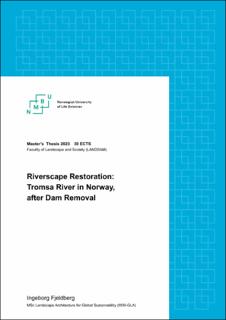| dc.description.abstract | Dams have been created in existing waterways to serve humans for centuries. For example, they have been used for different purposes, such as timber floating, grain mills, or electricity production. Today many of these dams remain unused and abandoned, disrupting ecosystems as they prevent the water from flowing naturally in the waterways. These human-made structures split habitats, fragment the landscape, and create hazards for migrating fish and other organisms living in the water. This global fragmentation raises concerns about habitat loss which may lead to species degradation and, in some cases, even distinction of certain species. As we know, nature is an interlinked web of ecological and geological processes where species are dependent and
co-dependent on each other. When species disappear or populations dramatically decrease, it can cause chain reactions with an unknown outcome. An effort to help nature heal on sites at a local scale might also help at a broader scale as the number of restored sites increases.
This thesis focuses on the case of the Tromsa river in Norway. At this site, a dam stopped being used for hydropower production in the 1060s and was partially removed in 2022. Such changes have considerable effects on the ecosystem in and around the river and affect any surrounding ecosystem. Through landscape analysis of the area, one solution was proposed, which evolved around recreating wetland areas similar to the site before and the remaining wetland areas. Any significant findings were generally that the place needs more harmony with the ecology and that important wetland areas have been transformed to serve anthropogenic interests. The proposal facilitates ecological connectivity and favors the migrating fish species, trout, and grayling, that have the Tromsa river as an essential part of their habitat. Parts of this thesis, such as analysis and discussion, are mainly represented graphically, supplemented with text where an explanation is needed. | |
